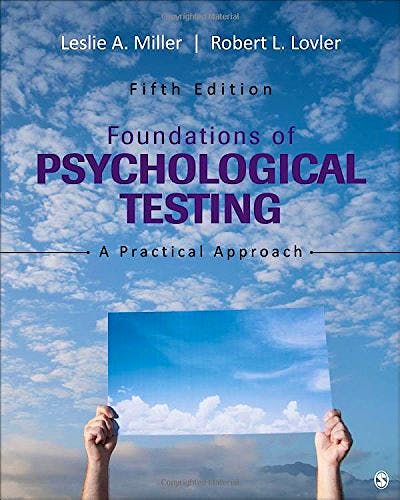

No hay productos en el carrito



Foundations of Psychological Testing. a Practical Approach
Miller, L. — Lovler, R.
5ª Edición Septiembre 2015
Inglés
Tapa dura
640 pags
1200 gr
17 x 23 x null cm
ISBN 9781483369259
Editorial SAGE PUBLICATIONS
LIBRO IMPRESO
-5%
149,14 €141,68 €IVA incluido
143,40 €136,23 €IVA no incluido
Recíbelo en un plazo de
2 - 3 semanas
Description
Offering a clear introduction to the basics of psychological testing as well as to psychometrics and statistics, this practical book includes discussion of foundational concepts and issues, using real-life examples and situations students will easily recognize, relate to, and find interesting. A variety of pedagogical tools further the conceptual understanding needed for effective use of tests and test scores. Now aligned with the 2014 Standards for Educational and Psychological Testing, the Fifth Edition offers new and expanded content throughout.
Contents
SECTION 1: OVERVIEW OF PSYCHOLOGICAL TESTING
Chapter 1: What Are Psychological Tests?
Why Should You Care About Psychological Testing?
What Are Psychological Tests?
The History of Psychological Testing
Testing Today
The Defining Characteristics of Psychological Tests
Assumptions of Psychological Tests
Test Classification Methods
Psychological Assessment, Psychological Tests, Measurements, and Surveys
Locating Information About Tests
Chapter 2: Why Is Psychological Testing Important
The Importance of Psychological Testing
Who Uses Psychological Tests and for What Reasons?
The Social and Legal Implications of Psychological Testing
Chapter 3: Is There a Right or Wrong Way to Use Psychological Tests?
Ethical Standards for Psychological Testing
Appropriate Use of Psychological Tests
Testing Special Populations
Chapter 4: How Does Computerized Testing Work?
Computerized Testing
Computerized Adaptive Testing
Web-Based Assessment
Implications for the Future
SECTION II: PSYCHOMETRIC PRINCIPLES
Chapter 5: How Do Test Users Interpret Test Scores?
Levels of Measurement
Procedures for Interpreting Test Scores
Standard Scores
The Role of Norms
Chapter 6: What Is Test Reliability/Precision?
What Is Reliability/Precision?
Three Categories of Reliability Coefficients
Classical Test Theory
The Reliability Coefficient
Using Computer Software to Calculate Reliability
Interpreting Reliability Coefficients
Factors That Influence Reliability
Generalizability Theory
Chapter 7: How Do We Gather Evidence of Validity Based on the Content of a Test?
Sources of Evidence of Validity
The Appropriate Use of Various Validation Strategies
Evidence of Validity Based on Test Content/Content Validity
Face Validity
Chapter 8: How Do We Gather Evidence of Validity Based on Test-Criterion Relationships
What Is Evidence of Validity Based on Test-Criterion Relationships?
Methods for Providing Evidence of Validity Based on Test-Criterion Relationships
Selecting a Criterion
Does the Criterion Measure What It Is Supposed to Measure?
Calculating and Evaluating Validity Coefficients
Using Validity Information to Make Predictions
Ethical Issues Associated With Test Validation
Chapter 9: How Do We Gather Evidence of Validity Based on a Test’s Relation
to Constructs?
The Traditional Notion of Construct Validity
Gathering Evidence of Construct Validity
Factor Analysis
SECTION III: DEVELOPING AND PILOTING SURVEYS AND PSYCHOLOGICAL TESTS
Chapter 10: How Do We Construct, Administer, and Use Survey Data?
What Are Surveys?
Knowledge Acquisition and the Scientific Method
The Survey Research Method
The Scientific Method of Survey Design
Survey Reliability and Validity
Chapter 11: How Do We Develop a Test?
Why Develop a New Test?
Defining the Testing Universe, Audience, and Purpose
Developing a Test Plan
Composing the Test Items
Writing Effective Items
Writing the Administration Instructions
Chapter 12: How Do We Assess the Psychometric Quality of a Test?
Conducting the Pilot Test
Conducting Quantitative Item Analysis
Conducting Qualitative Item Analysis
Revising the Test
Validating the Test
Developing Norms and Identifying Cut Scores
Compiling the Test Manual
SECTION IV: USING TESTS IN DIFFERENT SETTINGS
Chapter 13: How Are Tests Used in Educational Settings?
Decision Making in the Educational Setting
Educators as Test Users
Psychological Test Use in Educational Settings
Norm-Referenced, Criterion-Referenced, and Authentic Assessment of Achievement
Chapter 14: How Are Tests Used in Clinical and Counseling Settings?
Models of Psychological Assessment
Tests Used for Diagnosis and Intervention
Neuropsychological Tests
Chapter 15: How Are Tests Used in Organizational Settings?
A Short History of Employment Testing
Pre-employment Testing
Performance Appraisal
© 2025 Axón Librería S.L.
2.149.0